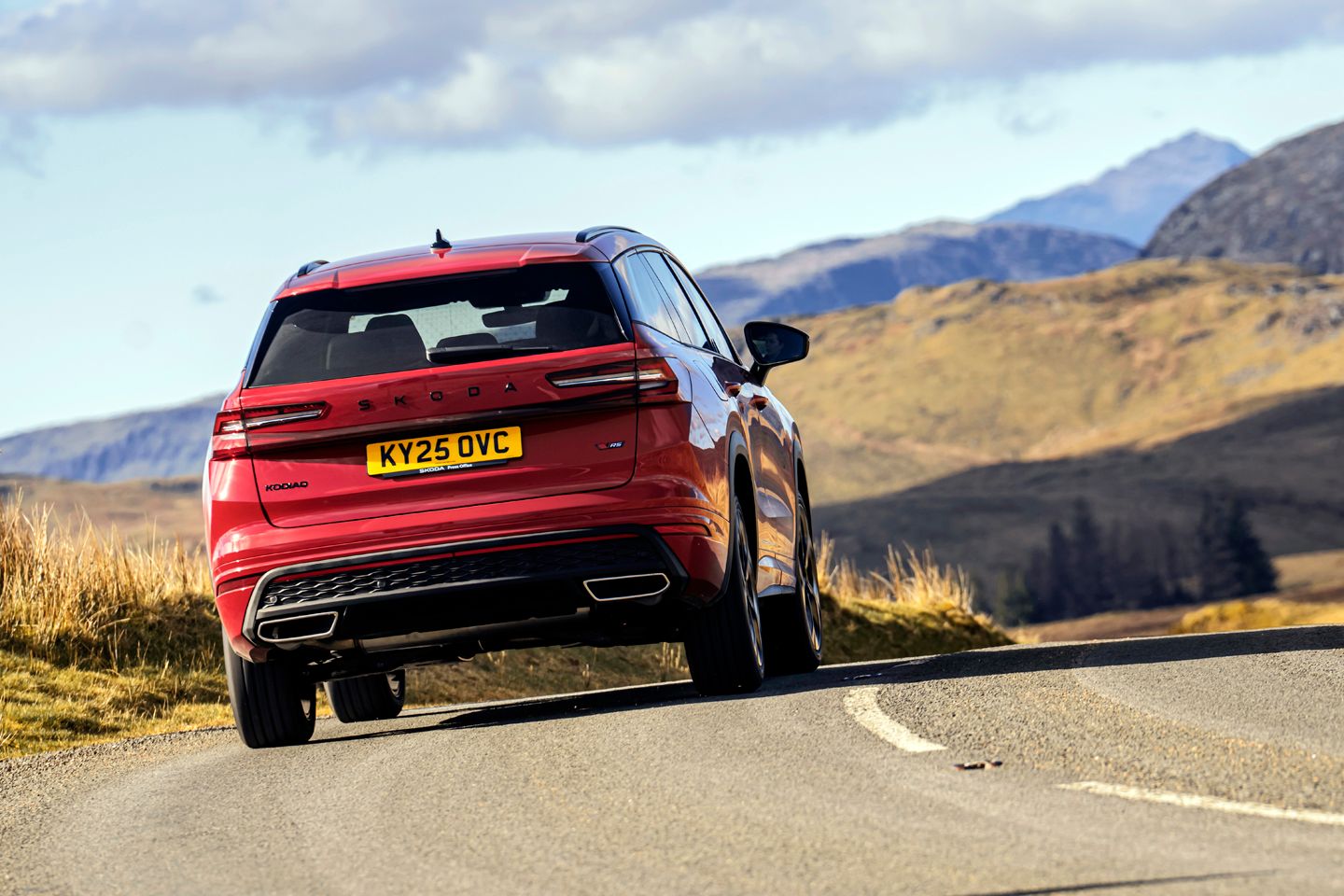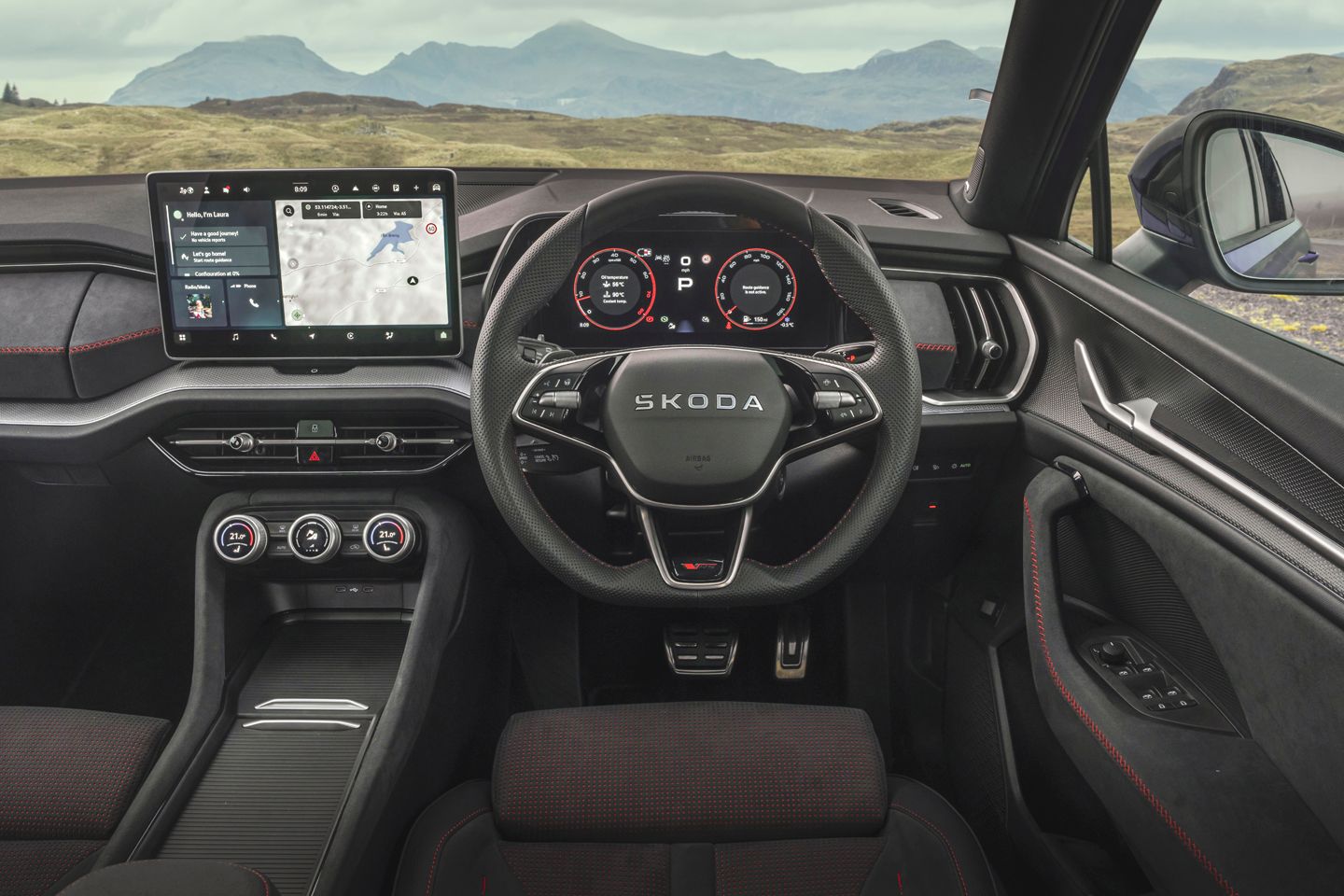
Going off the anecdotal barometer, the Skoda Kodiaq is more popular than ever. A mate just bought one, another deeply regrets selling his. Neither has five kids to fill the seven available seats; they just appreciate the space afforded by a large-than-average SUV – one that ticks several boxes, not least affordability. Neither seriously considered the vRS version (for the same reason the flagship variant of most lineups is dismissed), though it isn’t hard to see why Skoda continues to offer it: status is often a consideration in SUV purchases, and while the distance between the Kodiaq and the Cayennes and Range Rover Sports of this world is considerable, the vRS, with its mildly chunkier styling and implied performance bias, does advance you one step closer than a more humble variant might.
Thus it remains a constituent of the latest Kodiaq range and arrives in its burliest format yet. Skoda has previously vacillated between petrol and diesel for the vRS – the latter supplying a convenient and certainly model-appropriate 369lb ft of torque in its day – though unsurprisingly, it has opted again for the former, specifically the same flavour of 2.0-litre TSI you get in the current VW Golf GTI. That means your seven-seat, Skoda-badged SUV now comes with 265hp and (thanks in part to all-wheel drive and the omnipresent seven-speed DSG) the enlivening possibility of 0-62mph in 6.4 seconds and a top speed of 143mph. Roughly the same as a mid-spec, diesel-powered Range Rover Sport.
If you’re inclined to think that the second generation of Kodiaq has fallen short of the first in the looks department, you are not alone. The tedious rejigging of lights and grille and intakes says more about life cycle prerequisites than it does genuine design choices – yet it’s also true that the model possesses more physical presence than most crossovers, mostly due to its proportions. It is pleasingly big to behold, although it stops well short of imposing; precisely the sort of shaggy dog presence that likely endears it to families. Skoda’s knack for monetising a job-done, sensible-shoe vibe is here in spades, much more so than in its blancmange-like EV lineup. The vRS is marked out by its badges and flashier wheels, but nothing is intended to trouble that essential formula.


The interior follows suit, though here the styling choices are more authentic and to the benefit of the user. Given the car’s MQB-sharing relationship with the Superb, it is unsurprising to find some of the architectural hard points in similar places – yet there is a significant difference in appearance, mostly, it must be said, to the Kodiaq’s advantage. Of course, it helps that the vRS trim (denied to the Superb) adds some very nice sports seats and a comprehensive coating of microsuede everywhere. Usability, comfort, and space are present in lavish quantity, and by the time you’ve extinguished the speed limit warning and lane keep assist (right next to each other, as they should be, via a steering wheel button) and adjusted the climate using an actual dashboard-mounted control, you’ll be off the fence and firmly in the Kodiaq’s corner.
Nothing that happens after that is very likely to threaten this first impression. It is a mild surprise to discover that Skoda has supplied the vRS with a prominent and conspicuously fake four-pot burr in its default drive mode, one presumably piped in to satisfy anyone migrating (you’d assume reluctantly) to the Kodiaq from a Golf R. Mercifully, this disappears in Comfort, a setting that you’re unlikely to leave once selected (not least because mode selection requires too many dreary prods of the touchscreen) as it provides the sort of amenable ride and handling compromise that befits a high-sided, near two-tonne car intended primarily for the job of transporting sticky children.
Quite how briskly you want to do this is obviously up to you. Perhaps the nicest thing you can say about the merger of seven-seat SUV with GTI-grade EA888 is that for the most part it simply enhances the wider sense of convenience you’ve already bought into. Which is to say that providing the Kodiaq with 295lb ft of easily won torque – from an engine renowned for its mid-range generosity – does its ease of use no harm at all. It is quite possible that you might not ultimately drive quicker anywhere, but you’ll almost certainly get up to your chosen speed more swiftly and with the sort of satisfaction that comes from knowing there’s plenty more from where that came from, should you need it.


Or want it. The distinction there is pertinent because with a 204hp 2.0-litre TSI and 193hp 2.0-litre TDI also available in the Kodiaq lineup, the notion of actually wanting to press on occasionally is fairly integral to seeking the vRS out. Assuming that is true, the flagship indulges the impulse in roughly the sort of quantities you’d expect: it is legitimately ‘fast’ in a way that neither of its slower-to-rev siblings could claim to be, yet not abundantly, nonchalantly quick like a premium brand six-cylinder SUV. You need to work it that bit harder, inevitably – and potentially set your sights a little lower. But rarely on a public road will you be yearning for significantly more pace from the Kodiaq.
That’s because, much like the Octavia vRS and the punchier Superb Sportline that share its engine, Skoda never loses sight of the core model beneath the badge. The flagship might get Dynamic Chassis Control as standard, but the adaptive dampers are always at their best when permitting the sort of long-wave response that suits the Kodiaq’s existing laid-back appeal. You don’t need the firmer settings to access a surfeit of 4Motion grip, nor gain confidence from the fundamentally well-tuned steering. Possibly you’ll notice a few more drain covers on 20-inch wheels, but they won’t prevent you from making fairly rapid progress, nor appreciating the feel of it.
Actively enjoying it might be a stretch, although in fairness that is a quality not traditionally achieved by any Skoda vRS derivative, and therefore unlikely to surface for the first time in a seven-seat SUV. It says much that the total number of pews is still what defines the Kodiaq, no matter which engine you opt for. The vRS simply gilds the lily with a bit more speed and power – and you won’t find us arguing against that prospect, especially when it has been achieved without the need to plug anything in, and even when it lands the flagship the wrong side of £50k. If you really must have seats in the boot, and are understandably disinclined to spend £84k on the cheapest Defender 130 D350 (the best large SUV money can buy), the speeded-up Kodiaq is as worthy a choice as its reputation suggests.
SPECIFICATION | 2025 SKODA KODIAQ VRS
Engine: 1,984cc, four-cyl turbo
Transmission: 7-speed dual-clutch auto, all-wheel drive
Power (hp): 265@5,000-6,500rpm
Torque (lb ft): 295@1,650rpm-4,350rpm
0-62mph: 6.4sec
Top speed: 143mph
Weight: 1,828kg (DIN)
MPG: 33.3
CO2: 192g/km
Price: £52,595 (price as standard; price as tested £54,000, comprising Metallic Paint £410 Driving Assistance Plus Package £995)

